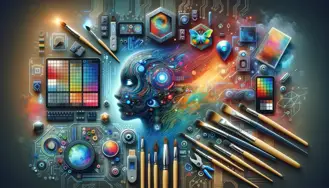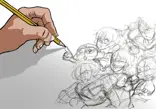Graphic design, also known as visual communication, is the practice of combining images, words, and ideas to convey information to an audience through visual media such as printed, published, or projected materials, and digital interfaces.
Graphic designers work creatively and visually to solve communication problems using images, symbols, or words, to assist organizations enhance visibility and distinction. By using multiple mediums, they convey a specific concept or identity that will be used in advertising and promotions.
These mediums include typography, shapes, color, images, print design, photography, animation, logos, and billboards. Graphic designers often collaborate on projects with artists, motion picture animators, and other creative professionals.

Graphic designers combine art and technology to communicate ideas through visuals and screen layouts by using many design elements to achieve artistic or decorative effects. They develop overall layouts and production designs for advertising, promotional materials, magazines, and company reports. Graphic designers operate at the intersection of text and images, meticulously selecting typeface, size, color, and line length for headlines, subtitles, and body text. Moreover, they strategize the interaction between images and text on a page or screen, meticulously allocating space for each element. Collaboration with copywriters is integral, as they carefully curate text layouts, determining placement in paragraphs, lists, or tables.
Their responsibilities typically involve:
- Meeting with clients or art directors to define the scope of a project
- Advising clients on strategies to target a specific audience
- Determining the message that the design should express
- Creating visuals that define a product or message
- Developing graphic and visual or audio illustrations for product renditions, logos, and websites
- Creating designs manually or using computer software packages
- Selecting colors, images, typestyles and layouts
- Presenting designs to clients or art directors
- Incorporating customer suggestions for modifications into the finished design
- Reviewing designs for errors before printing or publishing them
Graphic design is becoming increasingly important in sales and marketing products. Therefore, graphic designers, also called communication designers, often work closely with those in advertising, promotion, public relations, and marketing. Typically, designers specialize in a particular category or type of client; for example, some experts in motion graphics, while others work with print media and create signs or posters.
Graphic designers must stay updated with both new and current computer and graphic design software, either on their own or through official training programs. Moreover, they must be able to produce designs that are both aesthetically pleasing and appealing to customers. They use computer software or manual drawing to create initial concept sketches for design concepts.
It's crucial to enjoy every step in the design process, from start to finish. Since the industry is changing quickly, be aware to stay informed of any updates. That being said, don't follow fads mindlessly and disregard brilliant ideas. It is not a good idea to design just for the sake of design.
At times, designers may find themselves deeply immersed in their work, leading to a defensive reaction when faced with criticism. It is important not to take feedback personally and remain receptive to suggestions. Disapproval of a design does not necessarily reflect on one's skills as a designer.
Prioritize the development of your portfolio and exercise discernment when selecting its contents. Concentrate on showcasing your most exemplary works, ensuring they are presented in the most impressive manner possible. Potential employers may inquire about the contents of your portfolio and the rationale behind each inclusion, so be prepared to provide justifications for your selections

Now that computer tools are available, the ability to draw is less important than a good sense of design. Although it's not necessary to be proficient in fine art to work in graphic design, being able to create simple pencil sketches and drawings on paper is helpful. You can use these illustrations as a tool to explain your ideas to clients or supervisors, among other stakeholders. If you are worried about your drawing skills, you might want to look for drawing and sketching tutorials. Never give up; with perseverance and practice, your confidence and ease with drawing will undoubtedly increase.

The graphic design spans various media platforms, from printed materials to digital interfaces such as websites and applications. Whether it's displayed on paper, signs, or screens, each medium presents unique opportunities and limitations. Hence, comprehending the capabilities and constraints of the intended medium is essential for crafting impactful designs.
Indeed, designing for digital platforms like websites and apps necessitates an understanding of coding capabilities and limitations. While mastering website coding isn't mandatory, grasping high-level concepts and being able to communicate effectively with developers is crucial.
While designers enjoy creative freedom in sketching out ideas, they also recognize the importance of clearly defined constraints for project success. Understanding the limitations of the chosen medium is integral to the design process, without the need for coding proficiency.